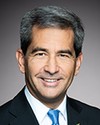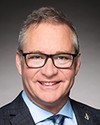Mr. Chair, thank you very much for the opportunity to appear today before the committee. I too would like to take a moment to express our condolences for the loss. Colleagues, our thoughts are with you.
As you know, our top priority at public health is the health and safety of Canadians. The Public Health Agency of Canada is actively monitoring and responding to the COVID-19 pandemic and planning for possible scenarios based on the evidence and as the science continues to emerge. Since the outset, PHAC and our provincial and territorial public health authorities across the country have been working together to ensure our preparedness and response measures are appropriate and adaptable, based on the latest science and evolving situation.
Within the agency, PHAC has activated its health portfolio operations centre to ensure effective planning and coordination of response efforts, in collaboration with international, federal, provincial and territorial partners. You have heard from many people from the public health agencies since the outset. Today I and my colleague, Cindy Evans, who's the acting vice-president in emergency management and is on a different side of the organization, are here, and I understand that you've invited us specifically to provide an overview of Canada's national emergency strategic stockpile, our inventory management and the disposal of medical masks and gloves.
I would like to talk about the NESS, as we call it, the national emergency strategic stockpile, but first we must understand the situation.
As you know, public health is a shared responsibility among federal, provincial, territorial and local governments. A fundamental assumption underpinning any emergency management is that the provinces and territories and the local governments are prepared to a reasonable extent for the most common emergencies.
The NESS is the federal government's health emergency stockpile. Our role in the stockpile is twofold. One is to provide surge capacity to provinces and territories at their request when their own resources are not sufficient. The other is that the NESS is the sole provider of certain assets required for rare public health emergencies—for example, costly or rarely used vaccines or antidotes.
To understand the NESS as it is today, it is helpful to understand its history and how it has evolved. It was created in 1952 during the early years of the Cold War. At the time, the biggest threat to national health and safety was the threat of nuclear attack. The NESS was authorized to stockpile essential health supplies for civil defence purposes. During the 1960s, the inventory expanded to include 200-bed hospitals, treatment centres, basic laboratories and blood donation units. Many of these were pre-positioned across Canada in schools, church basements, community centres and other locations.
In the 1980s and 1990s, the scope of the NESS expanded to include the capacity to respond to natural disasters and other emergencies by stockpiling the supplies needed to support evacuations and to care for displaced individuals, such as kits for setting up reception centres, mobile kitchens and airport disaster units.
The turn of the century marked a dramatic change in the nature of the international security and public health threats, marked by the September 11, 2001, terrorist attacks, the 2003 SARS outbreak and the 2009 H1N1 influenza pandemic.
During this period, the NESS evolved to focus more on chemical, biological, radiological and nuclear threats. It began to move away from beds and blankets and increased its holdings of antiviral medications, a key treatment in response to viral outbreaks such as influenza. The role of the NESS in procurement also evolved as a potential collaborative sourcing organization and a clearing house, paving the way for possible bulk procurement.
There have been ongoing changes and modernization to the NESS as an important part of the emergency management and preparedness response. In 2012, the NESS contained valuable medical and pandemic response supplies, but it also had outdated field hospitals and supplies that were no longer viable. Assets were held in various locations across nine cities and in approximately 1,000 pre-positioned sites in the provinces and territories, including within schools and community centres. Many of the sites had been moved or closed, so some of the assets were no longer in good quality due to long-term storage.
An independent assessment of the federal warehouse network looked at the footprint and found it was too large. The recommendation was to move from nine warehouse locations to six, as that would be more efficient and provide the same response capacity. We began to implement that solution. As a part of that, items of value were repositioned and other obsolete assets were disposed of in accordance with Treasury Board directives on disposal of surplus material.
In terms of inventory management, the NESS reviews its stock of equipment regularly. As part of the review, expired material is disposed of. In response to your specific question, in 2019, for example, approximately two million expired masks and 440,000 expired gloves were disposed of during the closure of one of the warehouses in Regina. The masks and gloves had been purchased in 2009. They passed the manufacturer's recommended limit of five years for their use.
The Public Health Agency follows strict guidelines when deploying materials. If the agency cannot account for the quality of the material, it will not deploy it. Even under current circumstances, where guidance allows for use of some expired personal protective equipment, we examine very closely any equipment that is sent over and is five years old or more. This is in accordance with manufacturers' guidelines.
When disposing of surplus assets, we offer them to partners, we sell them through GCSurplus and we recycle where we can. As a last resort, sometimes we do need to dispose of obsolete, expired or unusable assets.
It is important to note that when we have stockpiles that are about to expire, we do consider whether they can be donated for suitable use, but there are parameters around donations. For example, the World Health Organization will accept donated PPE, but the equipment must still be two years before its expiry date. That would meant that if we had something in stock for three years, we would have to donate it and rotate the stock.
When it comes to replenishing our assets, we do it based on risk and threat assessments, and credible scenarios that outline the types of risks that we face and may need to respond to. Our decisions to purchase assets focus on low-probability, high-impact events for which it makes the most sense for the federal government to be the sole provider. We have a planned and very nominal budget of about $2 million a year.
In summary, the NESS complements provincial, territorial and local capacity. We prepare for low-probability, high-impact events—for example, a terrorist attack or a major natural disaster—and we arrange for the continued availability of pharmaceuticals, equipment and medical supplies that are rare and difficult to obtain in a short time frame. We also fill a niche role in terms of stockpiling certain high-value items, such as the smallpox vaccine. The NESS really is intended to provide surge capacity, and it maintains its ability to facilitate bulk procurement with provinces and territories.
In order to respond to the unprecedented challenges of this pandemic, the NESS has been mobilized to support response efforts. We are leveraging bulk procurement capacity working with provinces, territories, Public Services and Procurement Canada and Health Canada to procure supplies for front-line health care workers. We have worked closely with the provinces and territories, Public Services and Procurement Canada and Health Canada to make these purchases and to allocate donations.
We've also ramped up our internal capacity with dedicated units for procuring PPE, identifying appropriate PPE for health service providers, preparing requisitions, reviewing product specifications and testing products. We've also deployed NESS equipment and supplies in response to requests for assistance from provinces and territories.
We have engaged the Canadian Armed Forces to facilitate logistics. This is making a huge difference. We went from about 15 to 30 deployments a year to 15 to 30 deployments a month. The volume is much bigger than anything we've been prepared for. The Canadian Armed Forces are working around the clock. Over two dozen members provide air and ground logistics and support for the global movement of these goods.
We also entered into an agreement with Amazon Canada, which leverages Canada Post and Purolator to facilitate the distribution of PPE and supplies purchased by the government. Since April 1, we've shipped approximately 1.2 million N95 respirator masks, six million surgical masks and eight million nitrile gloves to provinces and territories. More are expected to arrive and be distributed in the coming days.
The NESS has a long history. It has moved from a wartime stockpile to a more modern inventory of niche assets for low-probability, high-impact events. This pandemic has really been an opportunity for us to mobilize bulk procurement, large-scale shipping, and product verification and testing, and we've been mobilized in an unprecedented fashion. Responding to the events necessitated new and innovative partnerships and non-traditional approaches, all of which will inform the future of the NESS.
Mr. Chair, we thank you for the opportunity to be with you today to provide an overview of the national emergency strategic stockpile. We would be pleased to answer your questions.













